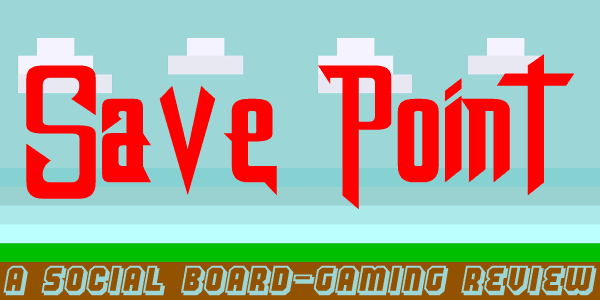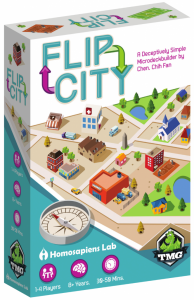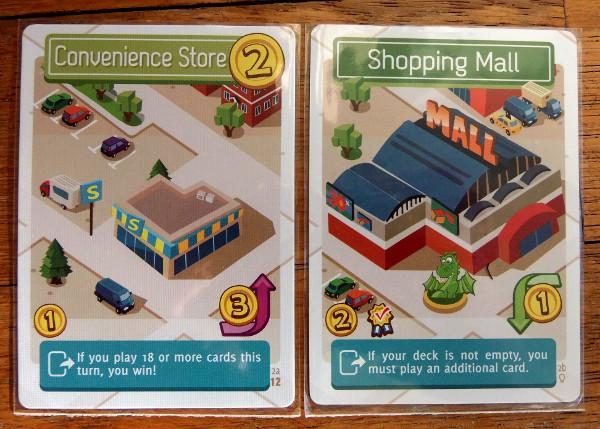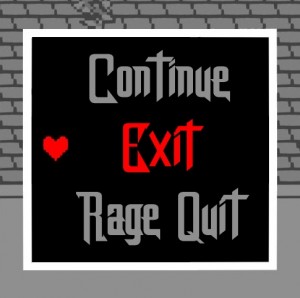
I love a good deck-builder, let me just put that right out there. I think they are incredibly fun to play and feature a high replayability value, while not demanding that players have to go out and purchase pack upon pack of cards looking for “uncommons” to give them an advantage over their opponent. There’s nothing wrong with CCGs – collectible card games – and there are quite a few of them that I enjoy; but for the casual gamer who isn’t looking to commit copious amounts of time, effort, and funds into a card game, a self-contained deckbuilder is certainly a good way to go.
 We’ve featured deckbuilder products here on Save Point before, but like all types of media (games, movies, books, TV shows, and more), not all games are created equal. I’ve had ‘Flip City’ in my collection for a while now; I picked it up online a few months back primarily as a game that my (very intelligent) six-year-old and I could play together. After many, many games with her, I introduced it to my usual group of game-playing adult friends at our weekly game night. How did both types of players react to the game? First, let me tell you about the game’s mechanics, then we’ll dive in a little deeper into thoughts and reactions.
We’ve featured deckbuilder products here on Save Point before, but like all types of media (games, movies, books, TV shows, and more), not all games are created equal. I’ve had ‘Flip City’ in my collection for a while now; I picked it up online a few months back primarily as a game that my (very intelligent) six-year-old and I could play together. After many, many games with her, I introduced it to my usual group of game-playing adult friends at our weekly game night. How did both types of players react to the game? First, let me tell you about the game’s mechanics, then we’ll dive in a little deeper into thoughts and reactions.
In ‘Flip City,’ the goal is to build your city via the cards in your deck, so that you can eventually satisfy one of two conditions needed to win: either you are able to generate 8 “Achievements” (indicated as medals on the cards) in one turn, or you can play 18 cards in one turn, with at least one of those cards being a Convenience Store. Each card in the game is a different type of generic building/area that one would normally find in a city; in your starting hand, each player begins the game with one copy of the aforementioned Convenience Store, along with 4 Residential Areas, one Apartment, one Hospital, one Factory, and one Central Park, for a total of 9 starting cards. Copies of all these cards, except the Residential Area, are available to buy out of the common-access trade row, along with an Office (and, if you have the first and to-date only expansion for the game, a Plumber’s Shop and a Flea Market).
The cards have certain symbols in the lower-left-hand part of the card that show what they will generate when played from your draw deck: coins indicate that you’ll gain money, medals indicate that you’ll gain Achievements, and a frowny-face emoji indicates Unhappiness. A player may draw from their deck as many cards as they’d like to play, in successive order, but cannot (normally) exceed two Unhappiness in any given turn; if they do, then their turn is over and their cards must go to the discard pile without making any further actions on that turn. Why would you ever want to go over the Unhappiness limit? you might ask – well, you might not want to, but certain cards have rules printed on the bottom that must be followed during gameplay. For example, your Residential Areas must be put into play if they are the next card on top of your draw deck – so if you already have two Unhappiness in play and a Residential Area is your next card, you are forced to play it and are thereby over the limit on “frowny faces,” as my daughter likes to say.
This mechanic adds a bit of a Vegas, “Twenty-One” kind of vibe to the game – you can press your luck, but prepare to be burned from time to time. With the money you generate on every turn, you can either purchase a new card from the trade row (to join the cards you’ve already played in your Discard Pile, before they all get shuffled back into your Draw Deck when said deck runs out of cards every few turns) or you can choose to “flip” a card in your discard pile. Each card has a “flip cost” printed in the lower-right-hand corner of the card, along with either a purple or green arrow; a green arrow indicates that the card can be flipped while in your discard pile to gain the money or other feature listed, and cards with purple arrows can be flipped if you pay the flip cost, thereby turning the card into a better building on the back side. For example, a Residential Area, which generates 1 Money and 1 Unhappiness when played, costs 1 unit of money to flip into an Apartment, which also generates 1 Money and 1 Unhappiness when played, but the key difference is that you are not forced to play the Apartment when it’s the next card in your draw deck, whereas you are forced to play that Residential Area. Other cards turn into buildings that generate more Money, increase your Unhappiness allowances, get more Achievements, etc.
With the amount of flipping cards that has to be done – and making sure you’ve kept track of what side the cards are supposed to be on, especially important when you reshuffle your discard pile back into your draw deck – and the necessity to keep track of what cards are in your discard pile, when they can be flipped, what they can be flipped for, etc. … the game gets to feeling like it has a lot of extraneous rules to keep track of from turn to turn. My daughter had difficulty grasping the “green arrow” concept of flipping cards while in the discard pile in order to generate something good to be used in that turn only. On the adult side of the game, most of our players felt that the game got very repetitive very quickly, and that patterns would emerge that essentially dictated how you had to play your strategy from game to game. This might be the first game I’ve ever run across where I actually think that the expansion actually detracts from the overall gameplay, instead of adding to it. It’s an intriguing concept for a game, but it gets bogged down by the repetitive mechanics and the copious amount of things to remember every turn.
EXIT: A game that is fun to play, but probably one that you’ll be content to put down after one play-through and come back to it another day.
Come back and visit us next week for another game to hear all about – if there are any games you like to play or that you’d like to see reviewed, please leave a comment below so we can connect with you!
Tony Schaab mixed up all this fake puke at home and then he went to this movie theater, hid the puke in his jacket, climbed up to the balcony, and then he made a noise like this: hua-hua-hua-huaaaaaaa… and then he dumped it over the side, all over the people in the audience. And then – this was horrible – all the people started getting sick and throwing up all over each other… and he never felt so bad in his entire life! A lover of most things sci-fi and horror, Tony is an author by day and a DJ by night. Come hang out with Tony on Facebook and Twitter to hear him spew semi-funny nonsense and get your opportunity to finally put him in his place.



